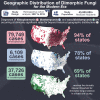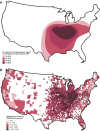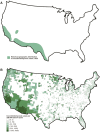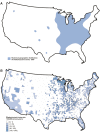The Geographic Distribution of Dimorphic Mycoses in the United States for the Modern Era
- PMID: 36366776
- PMCID: PMC10319749
- DOI: 10.1093/cid/ciac882
The Geographic Distribution of Dimorphic Mycoses in the United States for the Modern Era
Abstract
Background: The dimorphic mycoses (DMs) of the United States-Histoplasma, Coccidioides, and Blastomyces-commonly known as endemic mycoses of North America (in addition to Paracoccidioides) are increasingly being diagnosed outside their historical areas of endemicity. Despite this trend, the maps outlining their geographic distributions have not been updated in more than half a century using a large, nationwide database containing individual-patient-level data.
Methods: This was a retrospective analysis of >45 million Medicare fee-for-service beneficiaries from 1 January 2007 through 31 December 2016. Diagnoses of histoplasmosis, coccidioidomycosis, and blastomycosis were defined by International Classification of Diseases, Ninth/10th Revision, codes. The primary outcome was the incidence of histoplasmosis, coccidioidomycosis, and blastomycosis for each US county. Clinically meaningful thresholds for incidence were defined as 100 cases/100 000 person-years for histoplasmosis and coccidioidomycosis and 50 cases/100 000 person-years for blastomycosis.
Results: There were 79 749 histoplasmosis, 37 726 coccidioidomycosis, and 6109 blastomycosis diagnoses in unique persons from 2007-2016 across 3143 US counties. Considering all US states plus Washington, DC, 94% (48/51) had ≥1 county above the clinically relevant threshold for histoplasmosis, 69% (35/51) for coccidioidomycosis, and 78% (40/51) for blastomycosis.
Conclusions: Persons with histoplasmosis, coccidioidomycosis, and blastomycosis are diagnosed in significant numbers outside their historical geographic distributions established >50 years ago. Clinicians should consider DM diagnoses based on compatible clinical syndromes with less emphasis placed on patients' geographic exposure. Increased clinical suspicion leading to a subsequent increase in DM diagnostic testing would likely result in fewer missed diagnoses, fewer diagnostic delays, and improved patient outcomes.
Keywords: blastomycosis; coccidioidomycosis; dimorphic; endemic mycoses; histoplasmosis.
© The Author(s) 2022. Published by Oxford University Press on behalf of Infectious Diseases Society of America. All rights reserved. For permissions, please e-mail: journals.permissions@oup.com.
Conflict of interest statement
Potential conflicts of interest. M. A. O. reports grants, consulting fees, and personal fees from Pfizer. W. G. P. reports grants and personal fees from Merck and Co and the National Institutes of Health (not directly related to this work) and personal fees from Gilead Sciences. A. S. reports grants from Astellas Global Development Pharma, Inc; grants from Scynexis; grants from Cidara; and grants and personal fees from Mayne Pharma. A. C.-R. reports grants or contracts from the Metabolic Skeletal Disorders Training Grant through the National Institute of Arthritis and Musculoskeletal and Skin Diseases (T32AR060719; funding for author PhD stipend 2020–2022 through the Washington University School of Medicine) and support for attending the Cold Spring Harbor Laboratory Mechanisms of Aging Meeting 2022 (Division of Bone and Mineral Diseases, Washington University in St Louis). M. P. reports consulting fees from Clinton Health Access Initiative (external consulting as web developer). All other authors report no potential conflicts. All authors have submitted the ICMJE Form for Disclosure of Potential Conflicts of Interest. Conflicts that the editors consider relevant to the content of the manuscript have been disclosed.
Figures




Comment in
-
Out of Bounds: A Critical Appraisal of the Changing Geography of the Endemic Mycoses.Clin Infect Dis. 2023 Apr 3;76(7):1302-1303. doi: 10.1093/cid/ciac963. Clin Infect Dis. 2023. PMID: 36546694 No abstract available.
References
-
- Schwarz J, Furcolow ML. Some epidemiologic factors and diagnostic tests in blastomycosis, coccidioidomycosis and histoplasmosis. Am J Clin Pathol 1955; 25:261–5. - PubMed
-
- Edwards LB, Acquaviva FA, Livesay VT, Cross FW, Palmer CE. An atlas of sensitivity to tuberculin, PPD-B, and histoplasmin in the United States. Am Rev Respir Dis 1969; 99(Suppl 1):132. - PubMed
Publication types
MeSH terms
Grants and funding
LinkOut - more resources
Full Text Sources
Medical

